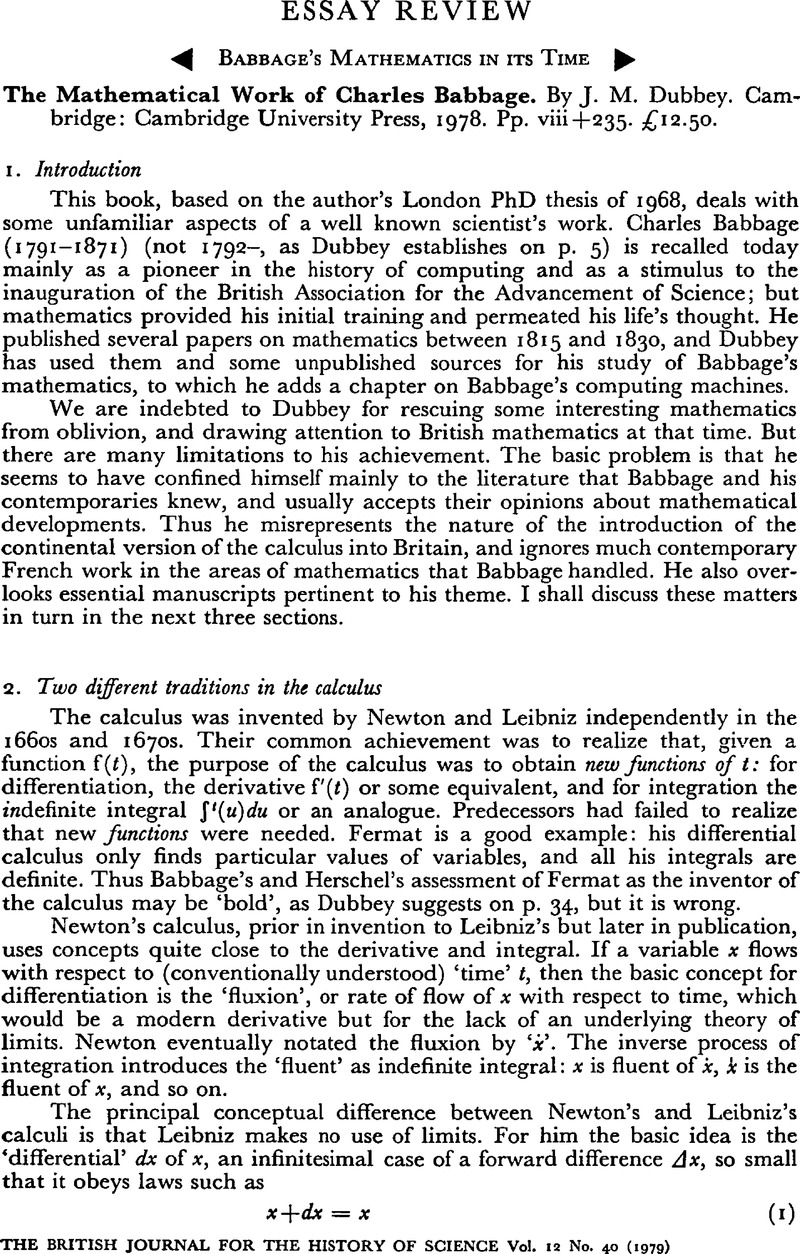Article contents
Babbage's Mathematics in its Time
Published online by Cambridge University Press: 05 January 2009
Abstract

- Type
- Essay Review
- Information
- Copyright
- Copyright © British Society for the History of Science 1979
References
NOTES
1 Newton used side dots to notate an equivalent to our homogeneous partial derivatives: our xyfxy would be his -f-, and so on (see Whiteside, D. T. (ed.), The mathematical papers of Isaac Newton, Cambridge, 1967, i, 289–94).Google Scholar Extension of this notation to functions of several variables would be geographically problematic, but probably not cause a worse situation than that produced by the zoo of notations introduced into Leibnizian multi-variate calculus (see Cajori, F., A history of mathematical notations, Chicago, 1929, ii, 196–241).Google Scholar
2 See Bos, H. J. M., ‘Differentials, higher-order differentials and the derivative in the Leibnizian calculus’, Archive for history of exact sciences, 1974, 14, 1–90.CrossRefGoogle Scholar
3 Cauchy, A-L., ‘Sur le développement des fonctions en série…’, Société philomatique de Paris, Bullétin des sciences, 1822, pp. 49–54Google Scholar (Oeuvres, série 2, ii, 276–82).Google Scholar
4 On the transition from Lagrange to Cauchy, see pp. 86–122 of my and Bos's articles in my (ed.), From the calculus to set theory, 1630–1910: an introductory history, London, 1978.Google Scholar
5 See An elementary treatise on the differential and integral calculus by S. F. Lacroix, Cambridge, 1816, p. iii.Google Scholar
6 This was done initially in Lagrange, 's ‘Sur une nouvelle espèce de calcul…’, Nouveaux mémoires de l'Académie des Sciences de Berlin, 1774Google Scholar, classe mathématique, 185–221 (Oeuvres, iii, 439–70).Google Scholar
7 Lagrange, J. L., Méchanique analitique, Paris, 1788; 2nd edn., 2 vols., Paris, 1811–1815Google Scholar (Oeuvres, vols, xi–xii).
8 See Lecture IV of Lagrange, 's Leçons sur le calcul des fonctions, Paris, 1806Google Scholar (Oeuvres, vol. x); and compare the more casual approach in his Théorie des fonctions analytiques, 1st edn., Paris, 1797, P. 15.Google Scholar
9 Arbogast, L. F. A., Du calcul des dérivations, Strasbourg, 1800.Google Scholar
10 Français, J. F., ‘Méthode de différentiation indépendante du développement des fonctions en séries’, Annales des mathématiques pures et appliquées, 1811–1812, 2, 325–31Google Scholar; ‘Mémoire tendant à démontrer la légitimité de la séparation des échelles de différentiation des fonctions qu'elles affectent…’, ibid., 1812–13, 3, 244–73; and ‘Du calcul des dérivations, ramené à ses véritables principes, ou théorie du développement des fonctions, et du retour des suites’, ibid., 1815–16, 6, 61–111. The first paper is by his brother F. J. Français and was published posthumously by him.
11 Servois, F. J., ‘Essai sur un nouveau mode d'exposition des principes du calcul différentiel’, Annales des mathématiques pures et appliquées, 1814–1815, 5, 93–140 (98–9)Google Scholar; reprinted Nismes, 1814, pp. 8–9.
11 Sarrus, F., ‘Essai sur le développement des fonctions en séries’, Annales des mathématiques pures et appliquées, 1821–1822, 12, 289–309.Google Scholar
13 See Babbage, C., Passages from the life of a philosopher, London, 1864Google Scholar, chapter XIV.
14 A good example of this situation occurs on p. 157, where Dubbey points out Babbage's failure to note commutativity, but does not himself reflect on the historical origins of this idea.
15 Gergonne, J. D., ‘Des équations fonctionnelles; par M. Charles Babbage…’, Annales des mathématiques pures et appliquées, 1821–1822, 12, 73–103.Google Scholar
16 De Morgan, A., ‘Calculus of functions’, Encyclopaedia metropolitana, London, 1835(?), ii, 305–89 (318).Google Scholar Compare the exchange in various papers by De Morgan, and Graves, J. T. in Philosophical magazine, 1836Google Scholar, series 3, 8 and 9.
17 Other developments in algebra at this time include the nascence of group theory and of linear algebra (see Wussing, H., Die Genesis des abstrakten Gruppenbegriffes, Berlin, 1967, pp. 15–24, 49–59).Google Scholar
18 Lacroix, , op. cit. (6), p. 1.Google Scholar Babbage himself translated the first part of Lacroix's book. Definitions of this kind in fact go back to John Bernoulli and Euler.
19 See especially Euler, 's ‘Summatio progressionum…’, Novi commentarii Academiae Scientiarum Petropolitanae, 1774, 18, 24–36Google Scholar (Opera omnia, series 1, xvi, section 1, 333–55)Google Scholar, where he handles the forms
20 Dubbey, , p. 124.Google Scholar Parseval's result is in ‘Mémoire sur les séries et sur l'intégration complète d'une équation aux différences partielles du second ordre, à coefficiens constans’, Mémoires présentés à l'Institut des sciences, lettres et arts, par divers savans, et lus dans ses assemblées: Sciences mathématiques et physiques, 1806, 1, 638–48.Google Scholar It is not quite the result known as ‘Parseval's theorem’ today (see my and J. R. Ravetz's Joseph Fourier, 1768–1830, Cambridge, Mass., 1972, pp. 238–41).Google Scholar A similar result was produced independently by B. Brisson in his ‘Mémoire sur l'intégration des équations différentielles partielles’, Journal de l'Ecole Polytechnique, 1808, cahier 14, 7, 191–261 (240–2).Google Scholar
21 Arbogast, L. F. A., Mémoire sur la nature des fonctions arbitraires qui entrent dans les intégrales aux différences partielles, St Petersburg, 1791.Google Scholar Compare Babbage, 's ‘An essay towards the calculus of functions’, Philosophical transactions of the Royal Society of London, 1815, 105, 389–423 (395).CrossRefGoogle Scholar
22 Babbage, C., ‘On the determination of the general terms of a new class of infinite series’, Transactions of the Cambridge Philosophical Society, 1827, 2, 217–25Google Scholar; Philosophical magazine, 1826, 67, 259–65.Google Scholar Incidentally, Dubbey does not give the full references of Babbage's papers in this appendix, and not always in the text, either.
23 Wilkes, M. V., ‘Babbage as a computer pioneer’, in The Babbage memorial meeting, London, 1971, 1–18Google Scholar; reprinted in Historia mathematica, 1977, 4, 415–30.Google Scholar
- 12
- Cited by


